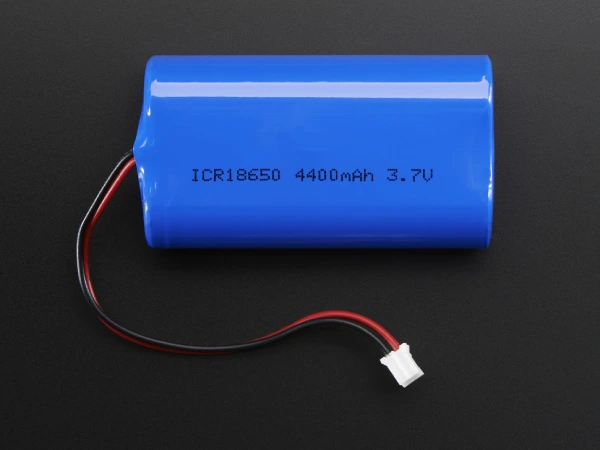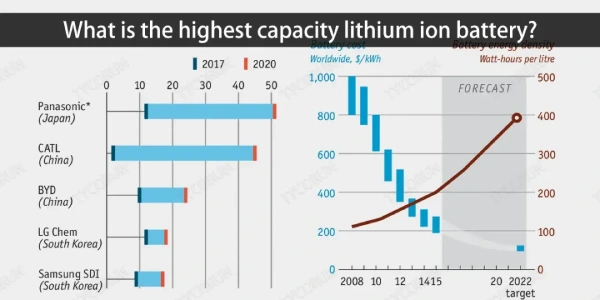
- Part 1. What is the battery capacity ?
- Part 2. What is battery capacity fade?
- Part 3. How to calculate battery capacity?
- Part 4. What is the high capacity battery?
- Part 5. What is the highest capacity li-ion battery?
- Part 6. Common li-ion battery capacity and applications
- Part 7. Can the li-ion battery capacity be increased?
- Part 8. Is the larger the capacity of the li-ion battery, the better?
- Part 9. Final Thoughts
Here we will introduce li-ion battery capacity, how to calculate it, battery capacity fade, high capacity batteries, and everything about li-ion battery capacity. Let’s start!
Part 1. What is the battery capacity ?
Battery capacity is the maximum energy a lithium battery can store and discharge into current under specific conditions. Lithium-ion battery capacity is typically expressed or measured in ampere-hours (Ah) or milliampere-hours (mAh). Manufacturing technology and chemical composition are the most important factors affecting lithium-ion battery capacity.
What affects battery capacity?
The size and mass of a lithium-ion battery, as well as its charge and depth of discharge, play a crucial role in determining the battery capacity . In addition to charge and discharge rates, environmental and battery temperatures can significantly shorten or increase the life and battery capacity .
Part 2. What is battery capacity fade?
Over time, battery capacity may decrease or increase. Internal resistance, chemical degradation, and physical damage can all cause battery capacity to decrease over time, a phenomenon known as capacity fade. The rate of capacity loss is affected by how the battery is used and maintained.
Part 3. How to calculate battery capacity?
When technical battery capacity, you need to know the current and time to calculate battery capacity. Current, usually measured in amperes (A) or milliamperes (mA), is the amount of charge flowing through the battery per unit time.
Time, usually measured in hours (h) or fractions of an hour, is the duration of a charge or discharge cycle.
The calculation formula for lithium-ion battery capacity is:
Capacity (Ah) = current (A) × time (h)
If your lithium-ion battery can deliver 2 A for 3 hours, you can calculate its capacity as:
Capacity (Ah) = 2 A x 3 h = 6 Ah
This indicates that the battery has a storage capacity of 6 amp hours and an output of 6 amps.
This method is a rough estimate. Because it does not take into account variables such as temperature, battery status, depth of discharge, charge and discharge rate, and battery life. All of these factors may affect battery capacity. Therefore, the actual battery capacity may be lower than the estimated figure.
Part 4. What is the high capacity battery?
High capacity battery is a popular name for some battery packs with relatively high capacity. There is no specific agreement on how high the voltage and capacity are and above is high capacity battery.
Advantages of high capacity lithium battery
Here we take high capacity lithium battery as an example to see the advantages of high capacity battery.
- High capacity lithium battery has relatively high energy. It has high storage energy density. The energy ratio of some high-capacity batteries has reached 460-600Wh/kg, which is about 6-7 times that of lead-acid batteries.
- High capacity lithium battery has a long service life, reaching more than six years. A battery with lithium iron phosphate as the positive electrode can be charged and discharged at 1C (100% DOD) and has a record of being used 10,000 times.
- The high capacity lithium battery has a high rated voltage (single operating voltage is 3.7V or 3.2V), which is approximately equal to the series voltage of three nickel-cadmium or nickel-metal hydride rechargeable batteries, making it easy to form a battery power pack.
- High capacity lithium battery has high power endurance. Among them, the lithium iron phosphate lithium-ion battery used in electric vehicles can reach a charge and discharge capacity of 15-30C, facilitating high-intensity starting and acceleration.
- The self-discharge rate of high capacity lithium batteries is very low. This is one of the most outstanding advantages of this battery. The self-discharge rate of high-capacity lithium batteries can generally be less than 1%/month, which is less than 1/20 of that of nickel-metal hydride batteries.
- High capacity lithium battery is light and weighs about 1/6-1/5 of lead-acid products in the same volume.
- The high capacity lithium battery’s self-discharge rate strongly adapts to high and low temperatures. It can be used in environments ranging from -20°C to 60°C. For example, Ufine Battery’s low-temperature lithium battery can be used at -45°C.
Part 5. What is the highest capacity li-ion battery?
As our electricity demand continues to grow, so does the capacity of batteries, especially in energy storage. Currently, the capacity of most energy storage batteries can reach 280Ah. While the current highest capacity li-ion batteries varies by manufacturer, advances in battery technology are critical in the energy storage space.
As renewable energy sources such as wind and solar are increasingly used to generate electricity, energy storage batteries are key to storing and delivering power when needed, making them an important part of the energy system. Continuing to invest in developing more advanced battery technology will ensure reliable and safe energy and help us transition to a more sustainable future.
Part 6. Common li-ion battery capacity and applications
| Li-ion Battery Capacity | Application |
|---|---|
| 14000 mAh | Electric bicycles, scooters, drones, etc. |
| 5000 mAh | Flashlight, remote control device, power wheel |
| 3000 mAh | Camera, power tools, photography lighting |
| 2500 mAh | Flashlights, toys |
Each battery listed above has its unique features and applications. Before purchasing a battery, consider factors such as voltage, capacity, and compatibility with your device.
Part 7. Can the li-ion battery capacity be increased?
The capacity of lithium-ion batteries can be increased by optimizing the battery’s design, chemistry, and production process.
How to increase lithium-ion battery capacity?
We’ve listed four methods below:
1. Increase electrode surface area
Enlarging the contact area between active ingredients and electrolytes can increase lithium battery capacity. The number of electrochemical reactions a battery can perform by increasing the electrode surface area is directly related to the amount of charge that can be stored and delivered in the battery.
2. Use materials with higher energy density
Energy density measures how much energy, weight, or space a battery can hold. Using materials with higher energy density can increase the power savings a battery of a certain size and weight can achieve. Some elements with high energy density are silicon, sulfur, and lithium metal.
3. Enhance electrolyte performance
The electrolyte is the conduit that transports ions between the electrodes. Improving the efficiency of the electrolyte can improve the conductivity, stability, and safety of the battery. Options such as additives, solid or gel electrolytes, or ionic liquids can improve electrolyte performance.
Part 8. Is the larger the capacity of the li-ion battery, the better?
Whether the capacity of a lithium battery is larger or better depends on the specific application scenarios and needs.
1. Capacity and usage time
Under ideal circumstances, regardless of the size and weight of lithium batteries, the larger the capacity of the lithium battery, the longer the battery life.
2. Capacity and stability
Although higher-capacity cells may appear more advantageous upon initial use, they may sacrifice electrode stability by using more capacity-increasing substances. This can cause the battery to rapidly degrade after a few charge cycles.
3. Energy density
Under the condition that the volume remains unchanged, the energy density of lithium batteries is directly proportional to the capacity. This means increasing energy density is key to increasing battery capacity. However, the energy density increase of lithium batteries is limited by technologies such as cathode materials, so it is difficult to achieve a breakthrough capacity increase simply by relying on existing materials.
4. Other factors
Battery type (such as lithium and nickel metal hydride), energy density, discharge rate, and fast charging protocols are all important factors that affect battery performance.
Part 9. Final Thoughts
To sum up, the li ion battery capacity is not the only factor that determines battery performance. Factors such as capacity, stability, energy density, discharge speed, battery type, fast charging protocol, and environmental protection should be comprehensively considered when selecting a battery. Therefore, we cannot simply say that the larger the lithium battery capacity, the better. However, we should make the appropriate choice based on specific needs and applications.
Related Tags:
More Articles

What is the Difference Between Silver Zinc Battery vs. Lithium-ion Rechargeable?
Compare silver zinc and lithium-ion rechargeable batteries: energy density, cycle life, safety, cost, and uses in drones, medical devices, EVs, and electronics.
What are Watts and Watt Hours in Battery?
Understand watt vs watt-hour in batteries: key differences, how to calculate capacity, and why they matter. Includes free comparison table.
Best 10 Blood Pressure Monitor Battery Review: Finding the Most Reliable
Are you looking for a reliable Blood Pressure Monitor battery? Here is a complete guide with the top 10 best blood pressure monitor batteries.
Bluetooth Headphone Battery Guide: All You Need to Know
Maximize headphone battery life with expert tips! Learn how to charge, check, troubleshoot, and choose the best bluetooth headphone battery in 2025.
LiFePO4 Battery VS. Lithium-ion Polymer Battery: Which One Is Best?
Comprehensive comparison of LiFePO4 vs Lithium Ion Polymer batteries: energy density, safety, lifespan, cost. Find out which battery suits your needs in 2025.





